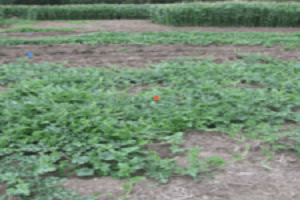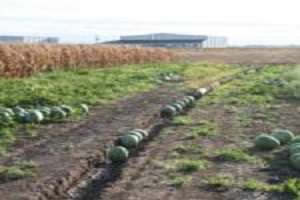By Dr. Daniel Leskovar
A study done by researchers at the Texas A&M AgriLife Research and Extension Center in Uvalde may help producers in the Texas Winter Garden region and other areas decide whether conservation tillage methods might benefit them in the production of high-value crops.
Conducted by Dr. Daniel Leskovar, a Texas A&M AgriLife Research vegetable physiologist and center director, in collaboration with Drs. Yahia Othman and Xuejun Dong, the study also includes research results on how strip tillage affects soil biological activity.

The study, titled “Strip tillage improves soil biological activity, fruit yields and sugar content of triploid watermelon,” investigated the influence of strip and conventional tillage practices at different water levels on the morphology, physiology, yield and quality of the seedless Majestic watermelon variety. Published in the November 2016 issue of Soil and Tillage Research journal, highlights and an abstract of the study can be found at: http://bit.ly/2k4yNKA.
Strip tillage is a conservation tillage practice involving minimum tillage to create a seedbed condition that disturbs only the portion of the soil to contain the seed row. The no-till area has crop residues and undisturbed soil to cover at least 30 percent of the topsoil surface.
The results showed strip tillage not only had a positive effect on watermelon quality and yield, it also had a positive effect on the soil’s biological activity, said Leskovar, the primary investigator for the study. He noted study results were also recently presented at the annual meeting of the Southern Region of the American Society for Horticultural Science in Mobile, Alabama.
“Research has been done on the use of conservation tillage for traditional crops, but there’s not much out there on using conservation tillage to produce high-value crops,” he said. “Despite the economic importance of watermelon in the U.S., which the U.S. Department of Agriculture’s National Agricultural Statistics Service estimates $483 million annually, no study we know of has assessed the influence of strip tillage on this crop.”
Leskovar said the experiment setup was designed as a circular split plot replicated four times with soil tillage and irrigation level as primary and secondary components. The portion of the study relating to the impact on watermelon was conducted from 2012-2014 using two tillage practices – strip and conventional – at three irrigation levels.
A center pivot system was used for irrigation at levels of 100 percent, 75 percent and 50 percent evapotranspiration. Evapotranspiration refers to the amount of water transferred from the land to the atmosphere by evaporation from soil and other surfaces, including plant leaves.
The study was conducted over three spring seasons on an established clay soil site at the center.
“We have been employing conservation and conventional tillage practices under the center pivot area from 2009 to the present, so the portion of the study relating to soil biological activity reflects six years of these tillage practices,” he said. “The crop history of the field we used for the study included corn as a cover crop in 2009, cotton in 2010 and corn again from 2011-2015.”

Plant morphology, physiology and yield were determined by measuring the photosynthesis rate, stomatal conductance and chlorophyll content index. Fruit firmness was determined using a digital force gauge, and fruit sugar content was measured using a digital refractometer.
Measurements were taken at flowering, fruit development and harvest stages. Vine length was also measured at the harvest stage.
Total marketable yield and fruit quality, based on firmness and sugar content, were determined during the harvest period, with soil chemical and microbial analyses conducted at the end of the experimental period.
“One of the most interesting results of the study was that marketable watermelon yield from strip till was higher than conventional till during all three years of the study,” Leskovar said. “Across the three years, the greatest difference in marketable yields between the strip and conventional tillage systems was in the fruit size from 5 to 8 kilograms or about 11 to 18 pounds, which was 50 percent of the total yield. In addition, the sugar content of the watermelon, which we measured using the Brix scale, increased significantly as a result of employing strip tillage.”
Leskovar said the increased yield and sugar content for marketable watermelon are factors that should appeal to producers interested in planting that crop and to consumers for the potential improvement in taste.
Dong, an AgriLife Research assistant professor and crop physiologist at the center, said because tillage practices are critical for sustaining soil quality necessary for successful crop growth and productivity, it is also important to assess soil chemical and biological properties in the study.
He also noted that using strip tillage in clay soil such as that found in the Winter Garden can also necessitate the occasional use of conventional tillage.

“The ecosystem of clay soil is complex and dynamic,” he said. “Limited tillage helps preserve the macropores of the soil to allow for water to penetrate and reach the plant roots, and to protect the soil biology. But the reduction of tillage disturbance alone cannot alleviate the compaction of clay soil, so it may be necessary to do conventional tillage every five years or so to loosen it and help preserve its biological ecosystem.”
The study showed tillage practices at the site had increased total bacteria in the soil by 49 percent, active bacteria by 27 percent, active and total fungi by 37 percent, nematodes by 275 percent and electrical conductivity by 14 percent as compared to conventional tillage.
“However, strip till also significantly increased the number of root-feeding nematodes, which are harmful to plant roots, but these may be related to the previous (corn) crop since it did not affect the watermelon plants,” said Othman, formerly a research associate at the center and now an assistant professor at the University of Jordan in Amman. “It also reduced phosphorus and nitrate content as compared to conventional till, a response that could either be due to higher uptake of these elements by the watermelon plants or due to leaching in the strip bands.”